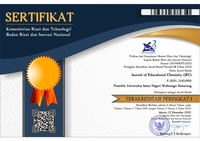Identifikasi Chemophobia dan faktor yang mempengaruhi Persepsi pada Mahasiswa
DOI:
https://doi.org/10.21580/jec.2020.2.2.6318Keywords:
chemopobia, identifikasi chemophobia, kecemasan kimiaAbstract
“Chemophobia” atau kecemasan kimia diyakini menjadi salah satu penyebab sedikitnya minat siswa terhadap jurusan kimia. Siswa juga kurang optimal dalam memahami pelajaran kimia. Siswa memandang kimia sebagai sesuatu yang negatif yang disebabkan oleh persepsi dan informasi yang mengenai kimia. Jenis penelitian ini adalah penelitian deskriptif dengan menggunakan pendekatan kualitatif. Penelitian ini bertujuan untuk mengidentifikasi eksistensi Chemophobia di kalangan mahasiswa serta faktor-faktor yang mempengaruhi pembentukan persepsi tersebut. Identifikasi dilakukan terhadap 60 mahasiswa jurusan sains dari beberapa universitas di Jawa dan Aceh menggunakan kuisioner googleform. Analisis dilakukan dengan tiga tahapan; penerimaan stimulus, pengelolaan stimulus, dan pembentukan persepsi. Berdasarkan hasil identifikasi didapatkan 55% responden tidak mengalami chemophobia sedangkan 45% responden mengalami chemophobia. Hal ini menunjukkan bahwa 45% responden memiliki ketakutan terhadap bahan kimia. Analisi pembentukan persepsi menunjukkan sebanyak 87% respoden mengaatakan bahan kimia berdampak positif. Hasil analiss faktor pembentukan persepsi dapat disimpulkan bahwa faktor internal memiliki pengaruh lebih besar dibandingkan dengan faktor eksternal dalam pembentukan persepsi tentang kimia jumlah yang mengalami Chemophobia sedikit.
Downloads
References
Binti Ibrahim, N. H., & Hj. Iksan, Z. B. (2018). Level of Chemophobia and Relationship with Attitude towards Chemistry among Science Students. Journal of Educational Sciences, 2(2), 52-65.
Chalupa, R. & Nesmerak, K. (2018). Analytical Chemistry as a Tool for Suppressing Chemophobia : An Introduction to the 5E-Principle Analytical Chemistry as a Tool for Suppressing Chemophobia : An Introduction to the 5E-Principle. Monatshefte fuer Chemie/Chemical Monthly, 149(9), 1527–1534. https://doi.org/10.1007/s00706-018-2224-9
Creswell, J. W. (2012). Educational research: Planning, conducting, and evaluating quantitative and qualitative research. In Educational Research (Vol. 4). Boston: Pearson.
Crowe, J. M. (2019). Chemophobia and the Relation to Names. Jacksonville: Junior College Chemistry.
Danarjati, D. P., Ekawati, A. R., & Murtiadi, A. (2013). Pengantar Psikologi Umum. Yogyakarta: Graha Ilmu.
Eddy, R. M. (2000). Chemophobia in the College Classroom: Extent, Sources, and Student Characteristics. Journal of Chemical Education, 77(4), 514–517.
Gribble, G. W. (2013). Food chemistry and chemophobia. Food Security, 5(2), 177–187.
Hamid, A. 2018. Chemophobia (Analisis Persepsi Masyarakat terhadap Bahan Kimia). Skripsi tidak dipublikasikan. UIN Sunan Kali Jaga: Jogjakarta
Kamaruddin, N., Ibrahim, N. H. & Surif, J. (2015.) Attribution factors of chemistry anxiety: what are they? International Education Postgrduates Seminars, Johor Bahru, Johor.
Keenan. (1986). Kimia Dasar Dan Terapan Modern Edisi Keempat, Jakarta : Erlangga
Kennedy, J. & Griffin,D. (2016). Chemophobia: How We Became Afraid Of Chemicals And What To Do About It. Diakses pada tanggal 13 september 2020 dari https://www.acs.org/content/acs/en/acswebinars/popularchemistry/chemophobia/video.html
Morais, C.(2015). Storytelling with Chemistry and Related Hands-On Activities: Informal Learning Experiences To Prevent “Chemophobia” and Promote Young Children’s Scientific Literacy. J. Chem. Educ. 92 (1), 58–65.
Downloads
Published
How to Cite
Issue
Section
License
The copyright of the received article shall be assigned to the journal as the publisher of the journal. The intended copyright includes the right to publish the article in various forms (including reprints). The journal maintains the publishing rights to the published articles.
Authors are permitted to disseminate published articles by sharing the link/DOI of the article at the journal. Authors are allowed to use their articles for any legal purposes deemed necessary without written permission from the journal with an acknowledgment of initial publication to this journal.

This work is licensed under a Creative Commons Attribution-NonCommercial-ShareAlike 4.0 International License.



